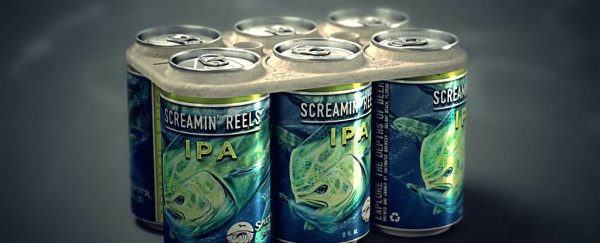We all know what six-pack rings can do to wildlife if they're not disposed of properly. One of the most famous examples is this beautiful little sea turtle, whose shell grew around the rings for four years until she was found, giving her a strange, peanut shape, and messing with her internal organs. Other creatures aren't so lucky.
The good news is one Florida-based brewery has had enough, and has developed edible six-pack rings that are designed to feed, rather than strangle, the wildlife they come into contact with.
Sure, it's great publicity for the brewery in question - Saltwater Brewery - and they did pair up with ad agency We Believers to develop what they claim to be the first entirely edible beer can packaging. But if viral marketing of the future equals finding solutions to major environmental problems, we are all in. Seriously, bring it on.
Not only does this product promise to be safe for wildlife, it's also made from recycled waste, Nathaniel Scharping reports for Discover.
The brewery claims to make its rings out of the wheat and barley byproducts leftover from the brewing process, and the resulting plastic is 100 percent biodegradable and safe to eat. "And if nothing is biting, the rings quickly decompose," says Scharping.
The company isn't being particularly forthcoming about how it manufactures its new six-pack rings - specifically, what it's putting in them to make them just as strong as existing rings, but still faster to decompose and also edible - so at this stage, we'll have to take their word for it.
But it says it released a test batch of 500 six-pack rings back in April, and now plans to replace all its six-pack rings with these news ones, which means meeting the brewery's 400,000 cans-per-month output.
Right now, production is slightly more expensive than regular six-pack rings, Chloe Olewitz reports over at Digital Trends, which means customers might have to pay more for their Saltwater Brewery beers to cover the cost. But the developers say they're confident they can get this cost down, saying it would be much easier for massive breweries to make their 3D-printing technique even more efficient.
"Production cost is expected to be between 10 and 15 cents per piece and could drop to be even lower. Very much on par with existing recyclable plastic alternatives," Marco Vega, co-founder of We Believers, told her.
As mentioned earlier, the details of the manufacturing process appear to be closely guarded at the moment, and we're yet to see studies showing that they work as intended, so we'll have to keep all that in mind for now. But the hope is that this technology will have some greater effect on the production of six-pack rings across the entire industry, because while it's certainly improved over the past few decades, it's by no means perfect.
Since 1989, the law requires that all six-pack rings manufactured in the US be produced using 100 percent photo-degradable plastic, which means it starts breaking down after a few days of being exposed to sunlight. But just because it starts breaking down within days of exposure doesn't mean it disappears completely during this time.
For plastic to be deemed compostable based on its biodegradation, disintegration, and toxicity, according to US, German, and international standards, just 60 percent biodegradation is required within 180 days. In other parts of Europe, 90 percent biodegradation is required within 90 days.
As Scharping points out, that leaves plenty of time to still harm wildlife. "And, they don't completely disappear, at least not for a long time, so they could still pose a risk to animals that eat them," he adds.
With estimates stating that the number of fish in our oceans will be outweighed by plastic waste over the next 35 years, one thing's for sure - we need to make a serious change in how we manufacture, distribute, and dispose of plastics in the coming years.
If we're not going to turn to rapidly composting, edible plastics, like Saltwater Brewery claims to have made, we might end up being entirely dependent on plastic-eating bacteria, which researchers around the world are now figuring out how to work with. Let's just hope something sticks.
